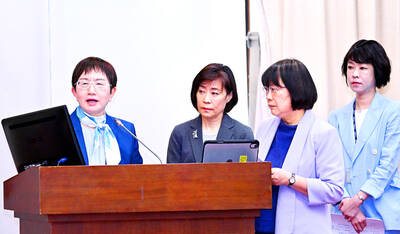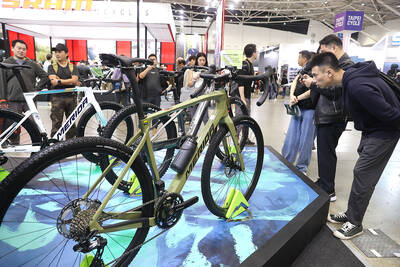Siemens said it is seeking to collaborate with local wind farm developers to build the nation’s first offshore wind turbines in 2016, a company executive said.
Siemens is working with two companies to supply wind energy solutions, Siemens Taiwan president and chief executive officer Erdal Elver told reporters last week.
In October, two wind energy companies inked agreements with the Ministry of Economic Affairs to help build offshore wind turbines with a combined annual capacity of 300 megawatts by 2020.
The ministry said it would then extend the program to increase total offshore wind power capacity to 3,000 megawatts in 2030.
The first winning bid was from Formosa Wind Power Co Ltd (海洋風力發電), an offshore wind turbine maker belonging to Swancor Industry Co Ltd (上緯企業). The second winner was a venture created by Taiwan Generations Corp (永傳能源), Century Iron and Steel Industiral Co Ltd (世紀鋼構) and CSBC Corp, Taiwan (台船).
Siemens is the world’s biggest off-shore wind turbine solution provider and has helped install farms with capacity totaling 1,600 megawatts in the UK, Germany and the US.
Siemens Taiwan, which holds the energy sector as its top revenue source for last year, said revenue grew at a faster-than-expected pace of 4 percent annually in the last fiscal year to NT$15 billion after it landed a power supply order from a local contract chipmaker.
The last fiscal year ran from Oct. 1 last year through September this year.
The company originally predicted it would only grow its revenue at the same pace as GDP this year, which is expected to expand 1.74 percent year-on-year.
Siemens said it expects to increase its revenue at the same rate as GDP next year on the back of better economic recovery in Taiwan and more construction programs, primarily new transportation systems to be launched in Taoyuan, Taipei and Greater Kaohsiung, Elver said.
However, Siemens is targeting revenue growth at double GDP growth next year, he said.
Taiwan’ GDP is expected to grow by 2.59 percent annually based on a forecast from the Directorate-General of Budget, Accounting and Statistics.
“Taiwan is still in a transition period. Certain industries are still in difficult times,” Elver said. “We believe next year will be a better year for certain industries such as the machine tool industry.”
The energy and industrial sectors would be the main driving forces next year, Elver said.
Electronic automation systems, and microcontrollers used in machine tools and motors are among industrial products provided by Siemens.

TECH CLUSTER: The US company’s new office is in the Shalun Smart Green Energy Science City, a new AI industry base and cybersecurity hub in southern Taiwan US chip designer Advanced Micro Devices Inc (AMD) yesterday launched an office in Tainan’s Gueiren District (歸仁), marking a significant milestone in the development of southern Taiwan’s artificial intelligence (AI) industry, the Tainan City Government said in a statement. AMD Taiwan general manager Vincent Chern (陳民皓) presided over the opening ceremony for the company’s new office at the Shalun Smart Green Energy Science City (沙崙智慧綠能科學城), a new AI industry base and cybersecurity hub in southern Taiwan. Facilities in the new office include an information processing center, and a research and development (R&D) center, the Tainan Economic Development Bureau said. The Ministry

ADVERSARIES: The new list includes 11 entities in China and one in Taiwan, which is a local branch of Chinese cloud computing firm Inspur Group The US added dozens of entities to a trade blacklist on Tuesday, the US Department of Commerce said, in part to disrupt Beijing’s artificial intelligence (AI) and advanced computing capabilities. The action affects 80 entities from countries including China, the United Arab Emirates and Iran, with the commerce department citing their “activities contrary to US national security and foreign policy.” Those added to the “entity list” are restricted from obtaining US items and technologies without government authorization. “We will not allow adversaries to exploit American technology to bolster their own militaries and threaten American lives,” US Secretary of Commerce Howard Lutnick said. The entities

Minister of Finance Chuang Tsui-yun (莊翠雲) yesterday told lawmakers that she “would not speculate,” but a “response plan” has been prepared in case Taiwan is targeted by US President Donald Trump’s reciprocal tariffs, which are to be announced on Wednesday next week. The Trump administration, including US Secretary of the Treasury Scott Bessent, has said that much of the proposed reciprocal tariffs would focus on the 15 countries that have the highest trade surpluses with the US. Bessent has referred to those countries as the “dirty 15,” but has not named them. Last year, Taiwan’s US$73.9 billion trade surplus with the US

The Taipei International Cycle Show (Taipei Cycle) yesterday opened at the Taipei Nangang Exhibition Center, with the event’s organizer expecting a steady recovery in the industry this year following a tough last year. This year, 980 companies from 35 countries are participating in the annual bicycle trade show, showcasing technological breakthroughs and market development trends of the bicycle industry at 3,600 booths, the Taiwan External Trade Development Council (TAITRA, 外貿協會) said in a statement. Under the theme “Ride the Revolution,” the exhibition has attracted more than 3,500 international buyers from 80 countries to preregister for the four-day event, which is expected to